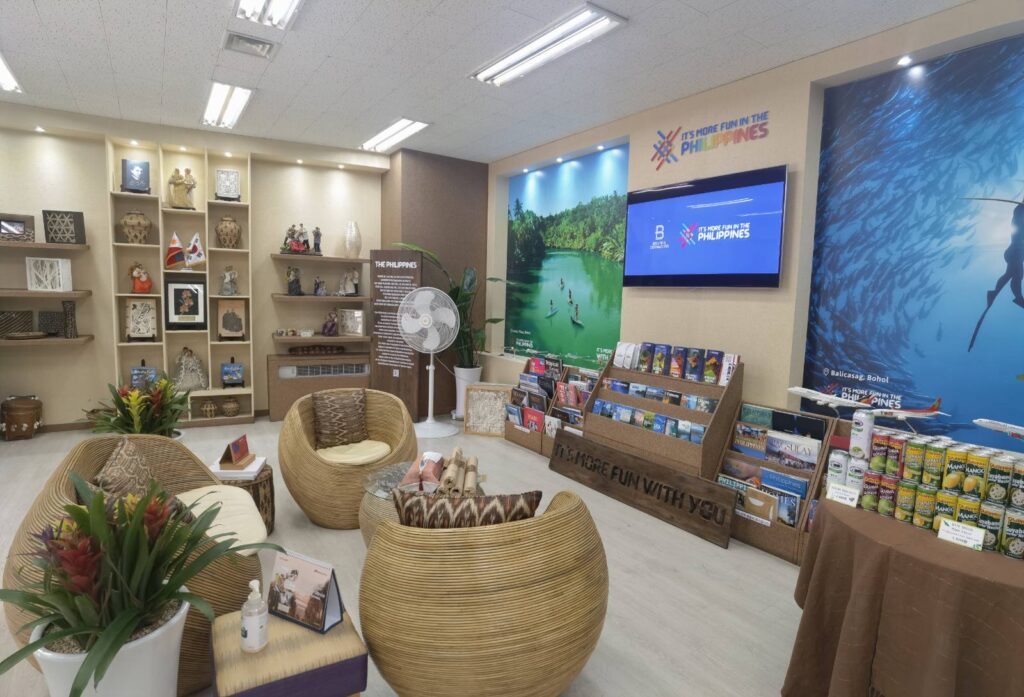While abroad, did you suddenly crave a taste of our home, the Philippines?
While we love trying food from other cultures, Filipino snacks undeniably remain our best companion when traveling.
This is why the Department of Tourism (DoT) has made it very accessible for us to visit our “home away from home” in Korea, a popular destination for Filipino tourists.
A one-stop-shop showroom for tourism information is set up with a pop-up store where you can also buy prominent Pinoy products.
At the entrance of the showroom, you can immediately spot our famous sorbetes (ice cream) cart, strategically displayed at the center of the pop-up store along with our favorite snacks and canned dishes.

More food products, as well as traditional furniture, crafts and decorations, will also welcome your Pinoy vibe as you enter the showroom.
The Department of Tourism-Korea said Seoul residents usually visit the pop-up store to buy canned tropical beverages, such as Filipino-produced coconut water, and calamansi– and mango-flavored juices. They also love our famous dried mango and banana chips.
Koreans who have stayed in the Philippines are also said to like visiting the store for Filipino condiments, as well as ready-made adobo, tocino, menudo and caldereta sauces.
“To those who have been in the Philippines, these are the food products that they miss and want to share with their families and friends,” the DoT-Korea staff told Daily Tribune.
There are also brochures and other information materials that can be read by Koreans and other foreigners when they want to know more about the Philippines.
DoT-Korea said the Philippine showroom has become a primary tool for them to keep the Filipino presence alive in Korea.
Since its establishment in July 2012, the showroom has guided not only Koreans but also other foreigners about culture of and top tourist destinations in the Philippines — a must-visit.

Koreans top visitors in Philippines
During our visit to the showroom, the DoT-Korea bared that the Philippines and Korea have a shared presence in their respective countries.
This is because Koreans have remained the top foreign visitors in the Philippines since 2010.
Before the Covid-19 pandemic in 2020, the DoT recorded close to two million Koreans traveling in the Philippines for leisure in 2019. It noted a remarkable growth of tourists to 22.48 percent from 2018.
As the Philippines was starting to recover from the global health crisis in 2022, the DoT recorded an influx of 2.65 million tourists coming into the country. Of the total figure, 428,014 were Koreans.
The DoT said the number of Korean tourists visiting the Philippines became the second-highest market source of the country since it lifted the travel restrictions after the serious threat of the pandemic.

Moreover, the number of travelers bound for the Philippines continued to increase in the first quarter of 2023 — recording 361,985 arrivals by nationality and 359,699 arrivals by country of residence. With this, Korea remained the top source of the market since January of this year.
Here’s why Koreans preferred to visit the Philippines, according to DoT-Korea:
Proximity
The Philippines is the closest tropical destination to Korea. With only around three and a half hours of travel time, Koreans can easily travel to the Philippines for a weekend getaway. They usually pack their things to travel to the Philippines on a Friday night, then go back to Korea on early Monday morning.
Travel Cost
It said that the Philippines has low-cost carriers that are very advantageous for Koreans in terms of cost, quality and sustainability. They can also avail of the affordable costs of tour packages, as well as tourism goods and services.
Ease of Travel
Having frequent flights to the Philippines must also be advantageous for Koreans. Aside from Ninoy Aquino International Airport and Clark International Airport in Luzon, there are also direct flights bound to the Philippines’ secondary gateways like Mactan-Cebu International Airport in Visayas and Davao International Airport in Mindanao. It’s hassle-free for them to visit our three main archipelagos.

Natural Attractions
DoT said Koreans admire the beautiful sceneries and beaches of the Philippines — it became the perfect destination for Koreans to relax, especially on the weekend. This is shown on the Arrival/Departure Cards and Annual Visitor Sample Survey in 2019.
Visiting Friends and Relatives
According to the Korean Ministry of Foreign Affairs, the number of overseas Korean residents in the Philippines totaled to 85,000 — which largely consists of expatriates from Korea and people born in the Philippines with Korean ancestry. It forms the second-largest Korean diaspora community in Southeast Asia.
Subsequently, many Koreans travel to the Philippines to visit their families, relatives and friends who have been permanently residing in our country.
Wide Use of English
Meanwhile, the recent English Proficiency Index showed the Philippines ranked 22nd out of 111 countries, receiving a “high proficiency” level in the English language. In Asia, the Philippines ranked second highest, next to Singapore.
Hence, the Philippines became Korea’s preferred country for learning “English as Second Language” due to its proximity, affordable cost, English proficiency ranking and excellent English learning programs and teachers. Learning through practice became very convenient among Koreans since English is widely spoken in the Philippines.
Intensive Promotions
Recognizing these market opportunities, the Department of Tourism established a foothold in Korea in 1989 by initially employing Korea-based marketing representatives until it created a DoT foreign office in Seoul in 2007 to conduct intensive marketing and promotions.
Korea Tourism Organization is likewise inviting Filipino travelers to visit the southern part of Korea.
This, as the Korean government, will open visa-free entry for Filipinos in Muan County located in Jeollanam-do province, South Korea.
The Philippines and Korea are set to celebrate the 75th anniversary of their bilateral relations in 2024.
